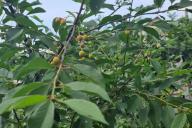At the end of the season, the leaves of onions and garlic - feathers - change color.
Yellowing in late summer tells gardeners it's time to dig up the heads and harvest.
Causes of yellowing in early summer
In hot climates, lodging and drying of onion and garlic feathers begins in the second half of July and is considered normal. Another reason is insufficient watering, because onions and garlic love water.

Yellowed tips of feathers indicate a lack of nitrogen, because with a nutritional deficiency the green part suffers immediately.
The leaves become shortened, change shape, and acquire a pale hue.
Despite the bitterness and sharp, aromatic taste, onions and garlic are loved by insect pests. Among them: onion fly, moth, mite.
Insect damage is often invisible, making it easy to miss the early stages of infestation and damage.
Once the larvae have hatched, it is impossible to save the crop, but it is possible to prevent further infection.
Diseases are dangerous and incurable. Bacterial rot and rust are often found in the beds. The bulb softens and dies, the above-ground part of the feathers turns pale and dries out.
Garlic leaves turn yellow and dry out not only due to diseases and pest damage, but also as a result of incorrect planting.
For example, if the feathers of winter garlic turn yellow in March, it means that it was injured in the winter frost.
Planting material planted in autumn should take root, but not sprout. Otherwise, it will suffer in frosts, and in spring it will produce leaves with diseased, yellow tips. A similar situation will occur if the heads are planted shallowly.
Garlic is damaged by rot, black mold and fusarium. Diseases appear on the bulbs - they slow down in growth, soften and change shape. The leaves become pale, yellow and dry.
Yellowing occurs in unfavorable weather conditions (early, warm spring, rainy summer).
Methods of solving the problem
Having discovered yellowed feathers on garlic, summer residents decide to eliminate the defect by tearing off the leaves.
Such manipulations are unacceptable and dangerous due to the reduction of the yield, because each leaf is responsible for the nutrition of a garlic clove or bulb. The damaged part does not provide adequate nutrition.
In hot weather, it is recommended to increase watering, and after the top layer of soil dries, loosen the bed. After this, feed the onions and garlic with nitrogen fertilizer (urea, manure). The amount of substances introduced into the soil should be moderate and minimal. Excess nitrogen will have a negative effect on the plants.
To combat flies and ticks, sprinkle with ash, tobacco dust or black pepper.
Affected feathers are cut out and burned. Crop rotation, poisoning and processing of planting material and digging up the soil can protect against insects.
Preventive measures help against diseases: soaking bulbs in a fungicide solution before planting in the ground. It is important to carefully inspect and select bulbs.
Garlic is fed with complex fertilizer to replenish the deficiency of nutrients.
After the snow cover melts, the beds are loosened because good air exchange in the root growth area helps to absorb nutrients, which is important when feeding. Mulching the soil helps as a preventive measure.
The natural cover of the bed protects the surface from crust formation and protects the seedlings from frost. The layer prevents the soil from drying out, which is important during the dry season.
Before solving the problem of yellowing, it is important to find the cause and ensure that the drying of feathers does not happen again in the next planting season.
Earlier we talked about protecting a site from flea beetles .








